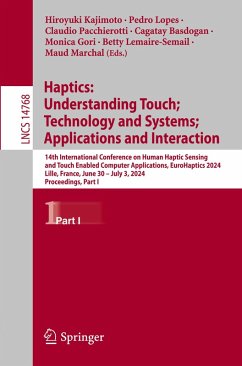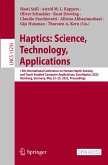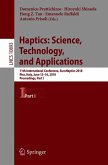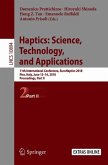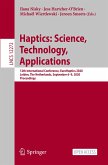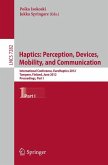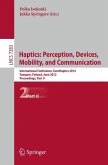Haptics: Understanding Touch; Technology and Systems; Applications and Interaction
14th International Conference on Human Haptic Sensing and Touch Enabled Computer Applications, EuroHaptics 2024, Lille, France, June 30 ¿ July 3, 2024, Proceedings, Part I
Herausgegeben:Kajimoto, Hiroyuki; Lopes, Pedro; Pacchierotti, Claudio; Basdogan, Cagatay; Gori, Monica; Lemaire-Semail, Betty; Marchal, Maud
Haptics: Understanding Touch; Technology and Systems; Applications and Interaction
14th International Conference on Human Haptic Sensing and Touch Enabled Computer Applications, EuroHaptics 2024, Lille, France, June 30 ¿ July 3, 2024, Proceedings, Part I
Herausgegeben:Kajimoto, Hiroyuki; Lopes, Pedro; Pacchierotti, Claudio; Basdogan, Cagatay; Gori, Monica; Lemaire-Semail, Betty; Marchal, Maud
- Broschiertes Buch
- Merkliste
- Auf die Merkliste
- Bewerten Bewerten
- Teilen
- Produkt teilen
- Produkterinnerung
- Produkterinnerung
The two-volume set LNCS 14768 + 14769 constitutes the refereed proceedings of the 14th International Conference on Human Haptic Sensing and Touch Enabled Computer Applications, EuroHaptics 2024, held in Lille, France, during June 30 - July 3, 2024.
The 81 full papers presented were carefully reviewed and selected from 142 submissions. They were organized in topical sections as follows: understanding touch; technology and systems; applications and interaction.
Andere Kunden interessierten sich auch für
![Haptics: Understanding Touch; Technology and Systems; Applications and Interaction Haptics: Understanding Touch; Technology and Systems; Applications and Interaction]() Haptics: Understanding Touch; Technology and Systems; Applications and Interaction55,99 €
Haptics: Understanding Touch; Technology and Systems; Applications and Interaction55,99 €![Haptics: Science, Technology, Applications Haptics: Science, Technology, Applications]() Haptics: Science, Technology, Applications30,99 €
Haptics: Science, Technology, Applications30,99 €![Haptics: Science, Technology, and Applications Haptics: Science, Technology, and Applications]() Haptics: Science, Technology, and Applications38,99 €
Haptics: Science, Technology, and Applications38,99 €![Haptics: Science, Technology, and Applications Haptics: Science, Technology, and Applications]() Haptics: Science, Technology, and Applications39,99 €
Haptics: Science, Technology, and Applications39,99 €![Haptics: Science, Technology, Applications Haptics: Science, Technology, Applications]() Haptics: Science, Technology, Applications30,99 €
Haptics: Science, Technology, Applications30,99 €![Haptics: Perception, Devices, Mobility, and Communication Haptics: Perception, Devices, Mobility, and Communication]() Haptics: Perception, Devices, Mobility, and Communication39,99 €
Haptics: Perception, Devices, Mobility, and Communication39,99 €![Haptics: Perception, Devices, Mobility, and Communication Haptics: Perception, Devices, Mobility, and Communication]() Haptics: Perception, Devices, Mobility, and Communication41,99 €
Haptics: Perception, Devices, Mobility, and Communication41,99 €-
-
-
The two-volume set LNCS 14768 + 14769 constitutes the refereed proceedings of the 14th International Conference on Human Haptic Sensing and Touch Enabled Computer Applications, EuroHaptics 2024, held in Lille, France, during June 30 - July 3, 2024.
The 81 full papers presented were carefully reviewed and selected from 142 submissions. They were organized in topical sections as follows: understanding touch; technology and systems; applications and interaction.
The 81 full papers presented were carefully reviewed and selected from 142 submissions. They were organized in topical sections as follows: understanding touch; technology and systems; applications and interaction.
Produktdetails
- Produktdetails
- Lecture Notes in Computer Science 14768
- Verlag: Springer / Springer Nature Switzerland / Springer, Berlin
- Artikelnr. des Verlages: 978-3-031-70057-6
- Seitenzahl: 552
- Erscheinungstermin: 3. November 2024
- Englisch
- Abmessung: 235mm x 155mm x 30mm
- Gewicht: 827g
- ISBN-13: 9783031700576
- ISBN-10: 3031700570
- Artikelnr.: 71249182
- Herstellerkennzeichnung Die Herstellerinformationen sind derzeit nicht verfügbar.
- Lecture Notes in Computer Science 14768
- Verlag: Springer / Springer Nature Switzerland / Springer, Berlin
- Artikelnr. des Verlages: 978-3-031-70057-6
- Seitenzahl: 552
- Erscheinungstermin: 3. November 2024
- Englisch
- Abmessung: 235mm x 155mm x 30mm
- Gewicht: 827g
- ISBN-13: 9783031700576
- ISBN-10: 3031700570
- Artikelnr.: 71249182
- Herstellerkennzeichnung Die Herstellerinformationen sind derzeit nicht verfügbar.
.- Understanding Touch.
.- Human Identification Performance of Vibrotactile Stimuli Applied on the Torso along Azimuth or Elevation.
.- Utilizing Absence of Pacinian Corpuscles in the Forehead for Amplitude-Modulated Tactile Presentation.
.- Optimizing Haptic Feedback in Virtual Reality: The Role of Vibration and Tangential Forces in Enhancing Grasp Response and Weight Perception.
.- Audiovisual-Haptic Simultaneity Perception Across the Body for Multisensory Applications.
.- Apparent Thermal Motion on the Forearm.
.- Surface Tactile Presentation to the Palm Using an Aerial Ultrasound Tactile Display.
.- Humans terminate their haptic explorations according to an interplay of task demands and motor effort.
.- The TIP Benchmark: A Tactile Image-Based Psychophysics-Inspired Benchmark for Artificial Tactile Sensors.
.- Towards Intensifying Perceived Pressure in Midair Haptics: Comparing Perceived Pressure Intensity and Skin Displacement between LM and AM Stimuli.
.- Virtual Hand Illusion Induced by Suction Pressure Stimulation to the Face.
.- Task-Adapted Single-Finger Explorations of Complex Objects.
.- Exploring Frequency Modulation in Decoding Edge Perception Through Touch.
.- The role of implicit prior information in haptic perception of softness.
.- Discovering the Causal Structure of Haptic Material Perception.
.- The visual and haptic contributions to hand and foot representation.
.- How Visualizing Touch Can Transform Perceptions of Intensity, Realism, and Emotion?.
.- Technology and Systems.
.- Asymmetric Hit-stop for Multi-user Virtual Reality Applications: Reducing Discomfort with the Movement of Others by Making Hit-stop Invisible.
.- Design of Haptic Rendering Techniques for Navigating with a Multi-Actuator Vibrotactile Handle.
.- Evaluating tactile interactions with fine textures obtained with femtosecond laser surface texturing.
.- Tactile Clip: A Wearable Device for Inducing Softness Illusion through Skin Deformation.
.- SENS3: Multisensory Database of Finger-Surface Interactions and Corresponding Sensations.
.- Variable Curvature and Spherically Arranged Ultrasound Transducers for Depth-Adjustable Focused Ultrasound.
.- The HapticSpider: a 7-DoF Wearable Device for Cutaneous Interaction with the Palm.
.- Vibrotactile cues with net lateral forces resulting from a travelling wave.
.- Enhancing the Perceived Pseudo-Torque Sensation based on the Distance between Actuators Elicited by Asymmetric Vibrations.
.- Presentation of Slip Sensation Using Suction Pressure and Electrotactile Stimulation.
.- Applications and Interaction.
.- Blindfolded operation as a method of haptic feedback design for mobile machinery.
.- Effects of Rendering Discrete Force Feedback on the Wrist during Virtual Exploration.
.- Viscous damping displayed by surface haptics improves touchscreen interactions.
.- Latency Compensation in Ultrasound Tactile Presentation by Linear Prediction of Hand Posture.
.- Pseudo-Frequency Modulation: A New Rendering Technique for Virtual Textures.
.- Do Vibrotactile Patterns on both Hands Improve Guided Navigation with a Walker?.
.- Data-driven Haptic Modeling of Inhomogeneous Viscoelastic Deformable Objects.
.- Perception of paired vibrotactile stimulus on the upper limb: implications for the design of wearable technology.
.- MoveTouch: Robotic Motion Capturing System with Wearable Tactile Display to Achieve Safe HRI.
.- Evaluation of HaptiComm-S for Replicating Tactile ASL Numbers: A Comparative Analysis of Direct and Mediated Modalities.
.- Memorable Vibration Pattern Design based on Writing Pattern.
.- Estimating Contact Force Rate Using Skin Deformation Cues.
.- Move or Be Moved: The Design of a Haptic-Tangible Manipulative for Paired Digital Education Interactives.
.- High-Fidelity Haptic Rendering through Implicit Neural Force Representation.
.- "It's Like Being on Stage": Staging an Improvisational Haptic-Installed Contemporary Dance Performance.
.- Human Identification Performance of Vibrotactile Stimuli Applied on the Torso along Azimuth or Elevation.
.- Utilizing Absence of Pacinian Corpuscles in the Forehead for Amplitude-Modulated Tactile Presentation.
.- Optimizing Haptic Feedback in Virtual Reality: The Role of Vibration and Tangential Forces in Enhancing Grasp Response and Weight Perception.
.- Audiovisual-Haptic Simultaneity Perception Across the Body for Multisensory Applications.
.- Apparent Thermal Motion on the Forearm.
.- Surface Tactile Presentation to the Palm Using an Aerial Ultrasound Tactile Display.
.- Humans terminate their haptic explorations according to an interplay of task demands and motor effort.
.- The TIP Benchmark: A Tactile Image-Based Psychophysics-Inspired Benchmark for Artificial Tactile Sensors.
.- Towards Intensifying Perceived Pressure in Midair Haptics: Comparing Perceived Pressure Intensity and Skin Displacement between LM and AM Stimuli.
.- Virtual Hand Illusion Induced by Suction Pressure Stimulation to the Face.
.- Task-Adapted Single-Finger Explorations of Complex Objects.
.- Exploring Frequency Modulation in Decoding Edge Perception Through Touch.
.- The role of implicit prior information in haptic perception of softness.
.- Discovering the Causal Structure of Haptic Material Perception.
.- The visual and haptic contributions to hand and foot representation.
.- How Visualizing Touch Can Transform Perceptions of Intensity, Realism, and Emotion?.
.- Technology and Systems.
.- Asymmetric Hit-stop for Multi-user Virtual Reality Applications: Reducing Discomfort with the Movement of Others by Making Hit-stop Invisible.
.- Design of Haptic Rendering Techniques for Navigating with a Multi-Actuator Vibrotactile Handle.
.- Evaluating tactile interactions with fine textures obtained with femtosecond laser surface texturing.
.- Tactile Clip: A Wearable Device for Inducing Softness Illusion through Skin Deformation.
.- SENS3: Multisensory Database of Finger-Surface Interactions and Corresponding Sensations.
.- Variable Curvature and Spherically Arranged Ultrasound Transducers for Depth-Adjustable Focused Ultrasound.
.- The HapticSpider: a 7-DoF Wearable Device for Cutaneous Interaction with the Palm.
.- Vibrotactile cues with net lateral forces resulting from a travelling wave.
.- Enhancing the Perceived Pseudo-Torque Sensation based on the Distance between Actuators Elicited by Asymmetric Vibrations.
.- Presentation of Slip Sensation Using Suction Pressure and Electrotactile Stimulation.
.- Applications and Interaction.
.- Blindfolded operation as a method of haptic feedback design for mobile machinery.
.- Effects of Rendering Discrete Force Feedback on the Wrist during Virtual Exploration.
.- Viscous damping displayed by surface haptics improves touchscreen interactions.
.- Latency Compensation in Ultrasound Tactile Presentation by Linear Prediction of Hand Posture.
.- Pseudo-Frequency Modulation: A New Rendering Technique for Virtual Textures.
.- Do Vibrotactile Patterns on both Hands Improve Guided Navigation with a Walker?.
.- Data-driven Haptic Modeling of Inhomogeneous Viscoelastic Deformable Objects.
.- Perception of paired vibrotactile stimulus on the upper limb: implications for the design of wearable technology.
.- MoveTouch: Robotic Motion Capturing System with Wearable Tactile Display to Achieve Safe HRI.
.- Evaluation of HaptiComm-S for Replicating Tactile ASL Numbers: A Comparative Analysis of Direct and Mediated Modalities.
.- Memorable Vibration Pattern Design based on Writing Pattern.
.- Estimating Contact Force Rate Using Skin Deformation Cues.
.- Move or Be Moved: The Design of a Haptic-Tangible Manipulative for Paired Digital Education Interactives.
.- High-Fidelity Haptic Rendering through Implicit Neural Force Representation.
.- "It's Like Being on Stage": Staging an Improvisational Haptic-Installed Contemporary Dance Performance.
.- Understanding Touch.
.- Human Identification Performance of Vibrotactile Stimuli Applied on the Torso along Azimuth or Elevation.
.- Utilizing Absence of Pacinian Corpuscles in the Forehead for Amplitude-Modulated Tactile Presentation.
.- Optimizing Haptic Feedback in Virtual Reality: The Role of Vibration and Tangential Forces in Enhancing Grasp Response and Weight Perception.
.- Audiovisual-Haptic Simultaneity Perception Across the Body for Multisensory Applications.
.- Apparent Thermal Motion on the Forearm.
.- Surface Tactile Presentation to the Palm Using an Aerial Ultrasound Tactile Display.
.- Humans terminate their haptic explorations according to an interplay of task demands and motor effort.
.- The TIP Benchmark: A Tactile Image-Based Psychophysics-Inspired Benchmark for Artificial Tactile Sensors.
.- Towards Intensifying Perceived Pressure in Midair Haptics: Comparing Perceived Pressure Intensity and Skin Displacement between LM and AM Stimuli.
.- Virtual Hand Illusion Induced by Suction Pressure Stimulation to the Face.
.- Task-Adapted Single-Finger Explorations of Complex Objects.
.- Exploring Frequency Modulation in Decoding Edge Perception Through Touch.
.- The role of implicit prior information in haptic perception of softness.
.- Discovering the Causal Structure of Haptic Material Perception.
.- The visual and haptic contributions to hand and foot representation.
.- How Visualizing Touch Can Transform Perceptions of Intensity, Realism, and Emotion?.
.- Technology and Systems.
.- Asymmetric Hit-stop for Multi-user Virtual Reality Applications: Reducing Discomfort with the Movement of Others by Making Hit-stop Invisible.
.- Design of Haptic Rendering Techniques for Navigating with a Multi-Actuator Vibrotactile Handle.
.- Evaluating tactile interactions with fine textures obtained with femtosecond laser surface texturing.
.- Tactile Clip: A Wearable Device for Inducing Softness Illusion through Skin Deformation.
.- SENS3: Multisensory Database of Finger-Surface Interactions and Corresponding Sensations.
.- Variable Curvature and Spherically Arranged Ultrasound Transducers for Depth-Adjustable Focused Ultrasound.
.- The HapticSpider: a 7-DoF Wearable Device for Cutaneous Interaction with the Palm.
.- Vibrotactile cues with net lateral forces resulting from a travelling wave.
.- Enhancing the Perceived Pseudo-Torque Sensation based on the Distance between Actuators Elicited by Asymmetric Vibrations.
.- Presentation of Slip Sensation Using Suction Pressure and Electrotactile Stimulation.
.- Applications and Interaction.
.- Blindfolded operation as a method of haptic feedback design for mobile machinery.
.- Effects of Rendering Discrete Force Feedback on the Wrist during Virtual Exploration.
.- Viscous damping displayed by surface haptics improves touchscreen interactions.
.- Latency Compensation in Ultrasound Tactile Presentation by Linear Prediction of Hand Posture.
.- Pseudo-Frequency Modulation: A New Rendering Technique for Virtual Textures.
.- Do Vibrotactile Patterns on both Hands Improve Guided Navigation with a Walker?.
.- Data-driven Haptic Modeling of Inhomogeneous Viscoelastic Deformable Objects.
.- Perception of paired vibrotactile stimulus on the upper limb: implications for the design of wearable technology.
.- MoveTouch: Robotic Motion Capturing System with Wearable Tactile Display to Achieve Safe HRI.
.- Evaluation of HaptiComm-S for Replicating Tactile ASL Numbers: A Comparative Analysis of Direct and Mediated Modalities.
.- Memorable Vibration Pattern Design based on Writing Pattern.
.- Estimating Contact Force Rate Using Skin Deformation Cues.
.- Move or Be Moved: The Design of a Haptic-Tangible Manipulative for Paired Digital Education Interactives.
.- High-Fidelity Haptic Rendering through Implicit Neural Force Representation.
.- "It's Like Being on Stage": Staging an Improvisational Haptic-Installed Contemporary Dance Performance.
.- Human Identification Performance of Vibrotactile Stimuli Applied on the Torso along Azimuth or Elevation.
.- Utilizing Absence of Pacinian Corpuscles in the Forehead for Amplitude-Modulated Tactile Presentation.
.- Optimizing Haptic Feedback in Virtual Reality: The Role of Vibration and Tangential Forces in Enhancing Grasp Response and Weight Perception.
.- Audiovisual-Haptic Simultaneity Perception Across the Body for Multisensory Applications.
.- Apparent Thermal Motion on the Forearm.
.- Surface Tactile Presentation to the Palm Using an Aerial Ultrasound Tactile Display.
.- Humans terminate their haptic explorations according to an interplay of task demands and motor effort.
.- The TIP Benchmark: A Tactile Image-Based Psychophysics-Inspired Benchmark for Artificial Tactile Sensors.
.- Towards Intensifying Perceived Pressure in Midair Haptics: Comparing Perceived Pressure Intensity and Skin Displacement between LM and AM Stimuli.
.- Virtual Hand Illusion Induced by Suction Pressure Stimulation to the Face.
.- Task-Adapted Single-Finger Explorations of Complex Objects.
.- Exploring Frequency Modulation in Decoding Edge Perception Through Touch.
.- The role of implicit prior information in haptic perception of softness.
.- Discovering the Causal Structure of Haptic Material Perception.
.- The visual and haptic contributions to hand and foot representation.
.- How Visualizing Touch Can Transform Perceptions of Intensity, Realism, and Emotion?.
.- Technology and Systems.
.- Asymmetric Hit-stop for Multi-user Virtual Reality Applications: Reducing Discomfort with the Movement of Others by Making Hit-stop Invisible.
.- Design of Haptic Rendering Techniques for Navigating with a Multi-Actuator Vibrotactile Handle.
.- Evaluating tactile interactions with fine textures obtained with femtosecond laser surface texturing.
.- Tactile Clip: A Wearable Device for Inducing Softness Illusion through Skin Deformation.
.- SENS3: Multisensory Database of Finger-Surface Interactions and Corresponding Sensations.
.- Variable Curvature and Spherically Arranged Ultrasound Transducers for Depth-Adjustable Focused Ultrasound.
.- The HapticSpider: a 7-DoF Wearable Device for Cutaneous Interaction with the Palm.
.- Vibrotactile cues with net lateral forces resulting from a travelling wave.
.- Enhancing the Perceived Pseudo-Torque Sensation based on the Distance between Actuators Elicited by Asymmetric Vibrations.
.- Presentation of Slip Sensation Using Suction Pressure and Electrotactile Stimulation.
.- Applications and Interaction.
.- Blindfolded operation as a method of haptic feedback design for mobile machinery.
.- Effects of Rendering Discrete Force Feedback on the Wrist during Virtual Exploration.
.- Viscous damping displayed by surface haptics improves touchscreen interactions.
.- Latency Compensation in Ultrasound Tactile Presentation by Linear Prediction of Hand Posture.
.- Pseudo-Frequency Modulation: A New Rendering Technique for Virtual Textures.
.- Do Vibrotactile Patterns on both Hands Improve Guided Navigation with a Walker?.
.- Data-driven Haptic Modeling of Inhomogeneous Viscoelastic Deformable Objects.
.- Perception of paired vibrotactile stimulus on the upper limb: implications for the design of wearable technology.
.- MoveTouch: Robotic Motion Capturing System with Wearable Tactile Display to Achieve Safe HRI.
.- Evaluation of HaptiComm-S for Replicating Tactile ASL Numbers: A Comparative Analysis of Direct and Mediated Modalities.
.- Memorable Vibration Pattern Design based on Writing Pattern.
.- Estimating Contact Force Rate Using Skin Deformation Cues.
.- Move or Be Moved: The Design of a Haptic-Tangible Manipulative for Paired Digital Education Interactives.
.- High-Fidelity Haptic Rendering through Implicit Neural Force Representation.
.- "It's Like Being on Stage": Staging an Improvisational Haptic-Installed Contemporary Dance Performance.

